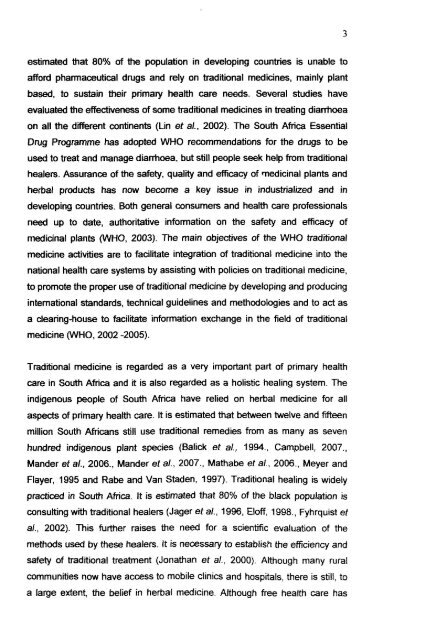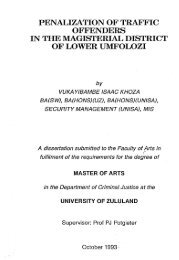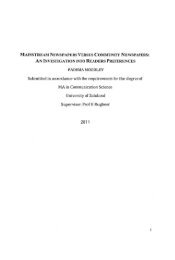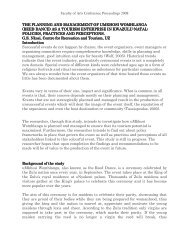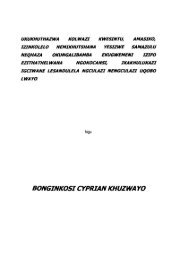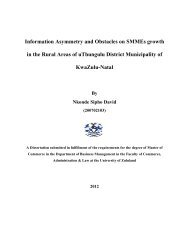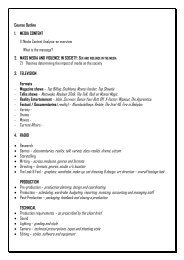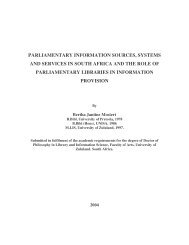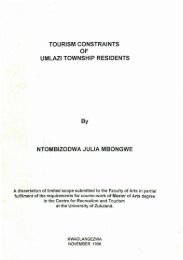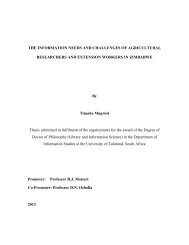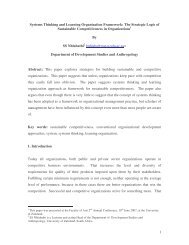The screening of medicinal plants traditionally used to treat ...
The screening of medicinal plants traditionally used to treat ...
The screening of medicinal plants traditionally used to treat ...
- No tags were found...
Create successful ePaper yourself
Turn your PDF publications into a flip-book with our unique Google optimized e-Paper software.
3estimated that 80% <strong>of</strong> the population in developing countries is unable <strong>to</strong>afford pharmaceutical drugs and rely on traditional medicines, mainly plantbased, <strong>to</strong> sustain their primary health care needs. Several studies haveevaluated the effectiveness <strong>of</strong> some traditional medicines in <strong>treat</strong>ing diarrhoeaon all the different continents (Un et al., 2002). <strong>The</strong> South Africa EssentialDrug Programme has adopted WHO recommendations for the drugs <strong>to</strong> be<strong>used</strong> <strong>to</strong> <strong>treat</strong> and manage diarrhoea, but still people seek help from traditionalhealers. Assurance <strong>of</strong> the safety, quality and efficacy <strong>of</strong> <strong>medicinal</strong> <strong>plants</strong> andherbal products has now become a key issue in industrialized and indeveloping countries. Both general consumers and health care pr<strong>of</strong>essionalsneed up <strong>to</strong> date, authoritative information on the safety and efficacy <strong>of</strong><strong>medicinal</strong> <strong>plants</strong> (WHO, 2003). <strong>The</strong> main objectives <strong>of</strong> the WHO traditionalmedicine activities are <strong>to</strong> facilitate integration <strong>of</strong> traditional medicine in<strong>to</strong> thenational health care systems by assisting with policies on traditional medicine,<strong>to</strong> promote the proper use <strong>of</strong>traditional medicine by developing and producinginternational standards, technical guidelines and methodologies and <strong>to</strong> act asa clearing-house <strong>to</strong> facilitate information exchange in the field <strong>of</strong> traditionalmedicine (WHO, 2002 -2005).Traditional medicine is regarded as a very important part <strong>of</strong> primary healthcare in South Africa and it is also regarded as a holistic healing system. <strong>The</strong>indigenous people <strong>of</strong> South Africa have relied on herbal medicine for allaspects <strong>of</strong> primary health care. It is estimated that between twelve and fifteenmillion South Africans still use traditional remedies from as many as sevenhundred indigenous plant species (Balick et al., 1994., Campbell, 2007.,Mander et al., 2006., Mander et al., 2007., Mathabe et al., 2006., Meyer andFlayer, 1995 and Rabe and Van Staden, 1997). Traditional healing is widelypracticed in South Africa. It is estimated that 80% <strong>of</strong> the black population isconsulting with traditional healers (Jager et al., 1996, El<strong>of</strong>f, 1998., Fyhrquist etal., 2002). This further raises the need for a scientific evaluation <strong>of</strong> themethods <strong>used</strong> by these healers. It is necessary <strong>to</strong> establish the efficiency andsafety <strong>of</strong> traditional <strong>treat</strong>ment (Jonathan et a/., 2000). Although many ruralcommunities now have access <strong>to</strong> mobile clinics and hospitals, there is still, <strong>to</strong>a large extent, the belief in herbal medicine. Although free health care has


